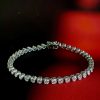Hatton Garden Collection: Fabulous new natural Burmese ruby, diamond and 18ct white gold eternity ring: an all-time classic with contemporary style
Original price was: £8,800.00.£4,395.00Current price is: £4,395.00.
This is a beautiful eternity ring which has just arrived from Hatton Garden. Ten stunning round brilliant cut Burmese rubies and two brilliant cut diamonds combine to create a captivating eternity ring, an all-time classic yet contemporary in style.
The rubies are high quality natural Burmese gems, beautifully hand cut, together weighing a total of 1.90 carats. The two diamonds are .24 carats, F/G in colour and VS in clarity, and the setting is 18ct white gold, hallmarked in London.
The ruby is the precious gemstone for all who were born in July, and the wedding anniversary dedicated to the ruby is the 40th. For either occasion, this timeless design is perfect. It is also practical, the half eternity style setting meaning it can be worn easily and often.
RRP £8,800. CCUK £4,395.
As with all our precious jewellery, this stunning ring carries a valuation certificate at the full retail price, together with a full 100% moneyback guarantee. It arrives in a smart case for presentation. If you do not know the ring size when ordering, this can be adjusted later in Hatton Garden, free of charge.
Fully hallmarked in England. This stunning ring carries an insurance valuation certificate at the full retail price, and a full 100% moneyback guarantee.
For more of the latest designs and classic favourites in the CountryClubuk Jewel Vaults, click here.
To arrange an appointment in Hatton Garden to view or discuss gemstones and designs, please call us on 020 7399 2960.
For more details about buying rubies, please read on . . .











